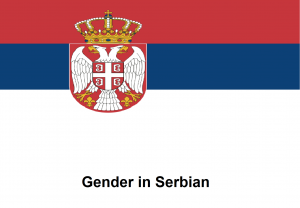Difference between revisions of "Language/Serbian/Grammar/Gender"
(Gender in Serbian) |
(Only some spelling, punctuation, and grammar edits) |
||
| Line 8: | Line 8: | ||
Please feel free to edit this page if you think it can be improved! | Please feel free to edit this page if you think it can be improved! | ||
Happy learning! | |||
. | . | ||
| Line 17: | Line 17: | ||
.<div style="font-size:300%;"> Gender (Rod imenice)</div> | .<div style="font-size:300%;"> Gender (Rod imenice)</div> | ||
Serbian language has three genders: ''masculine'' ('''muški rod'''), ''feminine'' ('''ženski rod''') and ''neuter'' ('''srednji rod'''). | The Serbian language has three genders: ''masculine'' ('''muški rod'''), ''feminine'' ('''ženski rod''') and ''neuter'' ('''srednji rod'''). | ||
If you | If you want to know the gender of a noun one of solution is to look it up in the dictionary and remember it. But there are also some rules which can help you determine the gender of the noun: | ||
* '' | * ''masculine nouns usually end in a '''consonant''''' (imenice muškog roda se obično završavaju konsonantom). | ||
But | But | ||
Revision as of 23:22, 4 December 2021
.
Hello Everyone, 😊
In today’s lesson we are going to study the following topic: ”GENDER” in Serbian
Please feel free to edit this page if you think it can be improved!
Happy learning!
.
.
Gender in Serbian
.
The Serbian language has three genders: masculine (muški rod), feminine (ženski rod) and neuter (srednji rod).
If you want to know the gender of a noun one of solution is to look it up in the dictionary and remember it. But there are also some rules which can help you determine the gender of the noun:
- masculine nouns usually end in a consonant (imenice muškog roda se obično završavaju konsonantom).
But
- some masculine nouns end in - o, and -e, usually masculine proper names. (neke imenice muškog roda se završavaju na -o i na -e, to su obično muška vlastita imena),
- some masculine nouns end in -a (neke imenice muškog roda se završavaju na -a )
Examples: prijatelj (friend), lekar (doctor), učitelj (teacher), otac (father), sin (son), deda (grandfather), prozor (window), mrav (ant), lav (lion), slon (elephant)
kamen (stone), Marko, Slavko, Djordje (proper names), sudija (judge), vođa (leader).
- feminine nouns usually end in - a, (imenice ženskog roda se obično završavaju na -a).
Examples:
žena (woman), majka (mother), baka (grandmother), ćerka (daughter), olovka (pen), mačka (cat), kiša (rain), suknja (skirt), žirafa (giraffe), lutka (doll), lopta (ball), sveska (notebook), knjiga (book), trava (grass)
- neuter nouns end in -e and -o, (imenice srednjeg roda se završavaju na -e i - o)
Examples:
dete (child), more (sea), selo (village), ime (name), pile (chicken), cveće (flowers), polje (field), jezero (lake), pero (feather), lišće (leaves), ćebe (blanket), drvo (tree), sunce (sun), jagnje (lamb).
Feminine singular noun can never end in -o or -e, and neuter singular noun can never end in -a or a consonant.
Also this can help you determine the gender of the noun :
- jednina (singular) množina (plural)
- taj (muški rod, masculine) ti
- ta (ženski rod, feminine) te
- to (srednji rod, neuter) ta
Example:
- taj mrav - ti mravi
- ta lutka - te lutke
- to dete - ta deca
.
